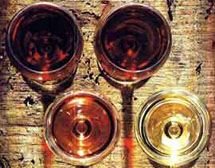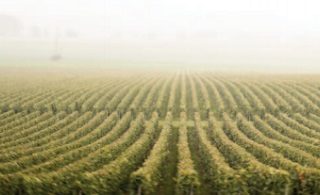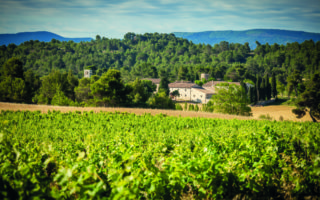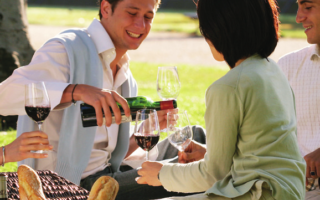A Short List of French Wine Terms


By FrenchEntrée
| TERM | DEFINITION |
|---|---|
| Appellation controlée: | (Ah-pell-ah-syon Kon-troll-ay): In French, the legal authorization for the name of the vineyard or wine region. |
| Aÿ: | One of the best vineyard villages of Champagne. |
| Beaujolais: | (Bo-zho-lay): The simple appellation of the big Beaujolais region: light short-lived fruity red wine. |
| Beaujolais Nouveau: | (Bo-zho-lay New-vo): Light, fruity red wine released for drinking annually in mid-November to the end of February. The best come from light sandy soil and are as strong as 12.5% alcohol. |
| Blanc de blancs: | (Blawn duh blawn): White wine produced exclusively from white grapes, significant in the French champagne country. |
| Blanc de noirs: | (Blawn duh Nwar): A white wine made from black grapes. Applies principally to French champagne made from the juice of black grapes (Pinot Noir) removed from the skins and fermented separately so it does not extract any color from the skins. |
| Brut: | (Brute): French term for “natural” or “unrefined,” employed in the Champagne district to designate the driest wines. Drier than extra-dry. |
| Cave: | (Cahv) French for cellar. |
| Chablis: | (Shab-lee): Distinctive, full-bodied white wine. |
| Champagne: | (Sham-pain): A uniquely French product, although its name has been borrowed by makers of sparkling wines all over the world who use the same process. |
| Champagne, Grande: | The appellation of the best area of cognac. |
| Château: | Shat-toe): French for “castle,” a wine estate associated with a vineyard. |
| Clos: | (Cloh): A term carrying some prestige, reserved for distinct, usually walled vineyards. |
| Cognac: | Town and region of western France and its brandy |
| Côte(s): | (Coat): Hillside; refers to better vineyards, generally superior to those on the plain. |
| Cru: | (Crew): French for “growth,” as in “first growth;” a specific vineyard classified according to its quality. |
| Cuvée: | (Kew-vay): The quantity of wine produced in a “cuve” or vat. Also a word that means “blend.” |
| Dégorgement: | (Day-gor-zha-mawnt): The process used in French champagne for removing sediment introduced by a secondary fermentation. |
| Demi-sec: | “Half-dry”: in practice more than half sweet. |
| Domaine: | (Doe-main): French for wine estate. |
| Doux: | (Doo): Sweet. |
| Goüt: | (Goo): Taste. |
| Grand cru: | (Grawn Crew): In reference to Champagne, a village (or “cru”) that has been given the highest rating (100 points) in the vineyard classification system. This term has a different definition in regard to Burgundy. |
| Imperiale: | (Em-pay-ree-ahl): Bordeaux bottle holding 8 ? normal bottles. |
| Jeroboam: | In Bordeaux, a six-bottle bottle, or triple magnum; in Champagne, a double magnum. No Champagnes are ever aged in jeroboams. |
| Macération carbonique: | Traditional Beaujolais technique of fermentation with whole bunches of unbroken grapes in an atmosphere saturated with carbon monoxide. Fermentation inside each grape eventually bursts it, giving vivid and very fruity mild wine for quick consumption. |
| Marc: | Grape skins after pressing; also the strong smelling brandy made from them. |
| Méthode champenoise: | (May-toad Shom-pen-wahz): The traditional laborious method of putting the bubbles in the champagne by refermenting the wine in the bottle. |
| Mise en bouteilles au château: | Bottled at the château, at the property or the estate. |
| Noble rot: | A form of mold that attacks the skins of ripe grapes in certain vineyards in warm and misty autumn weather. Instead of rotting the grapes, it withers them, causing the skin to grow soft and the juices evaporate. What is left is a super sweet concentration of everything in the grape except the water content. The world’s best sweet table wines are made of nobly rotten grapes. |
| Premier cru: | In reference to Champagne, a village (or “cru”) that has been given a high rating of 90-99 in the vineyard classification system (sometimes written as 1er cru). This term had a different definition in regard to Burgundy and Bordeaux. |
| Rosé: | (Ro-zay): Light pink wine, normally produced by crushing red grapes and allowing the juice to remain in contact with the skins for only a very short time, so that the wine obtains a rose-colored tinge. |
| Sec: | (Seck): Literally means dry, though with champagne it means medium-sweet. |
| Tête de Cuvée: | (Tet duh Kew-vay): French for “great growth;” term used to describe the best wines of an appellation. |
| Viticulteur: | Wine grower. |
Share to: Facebook Twitter LinkedIn Email
More in burgundy, champagne, legal, villages, vineyards, wine
By FrenchEntrée
Leave a reply
Your email address will not be published. Required fields are marked *



